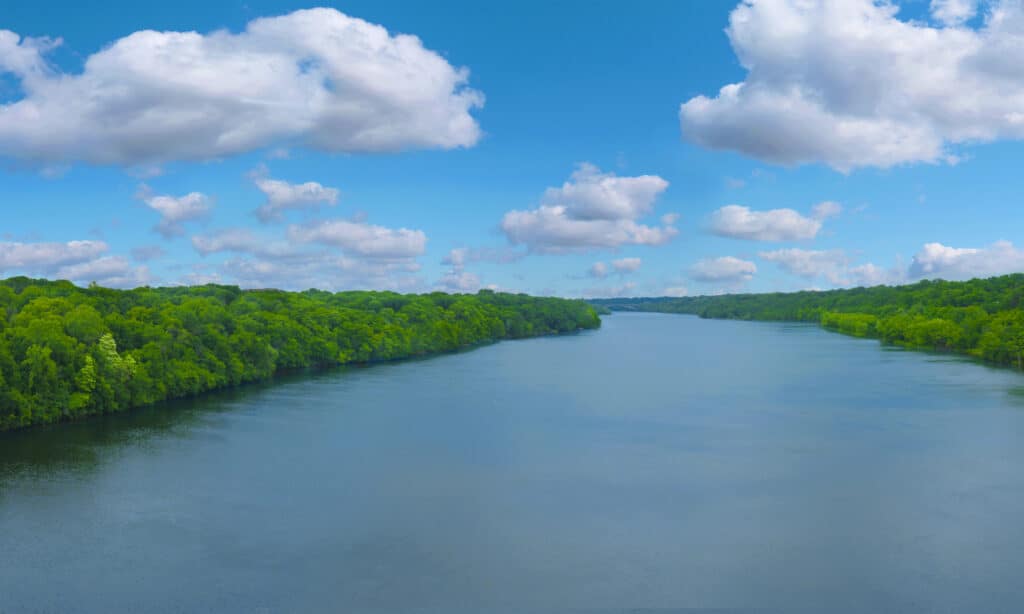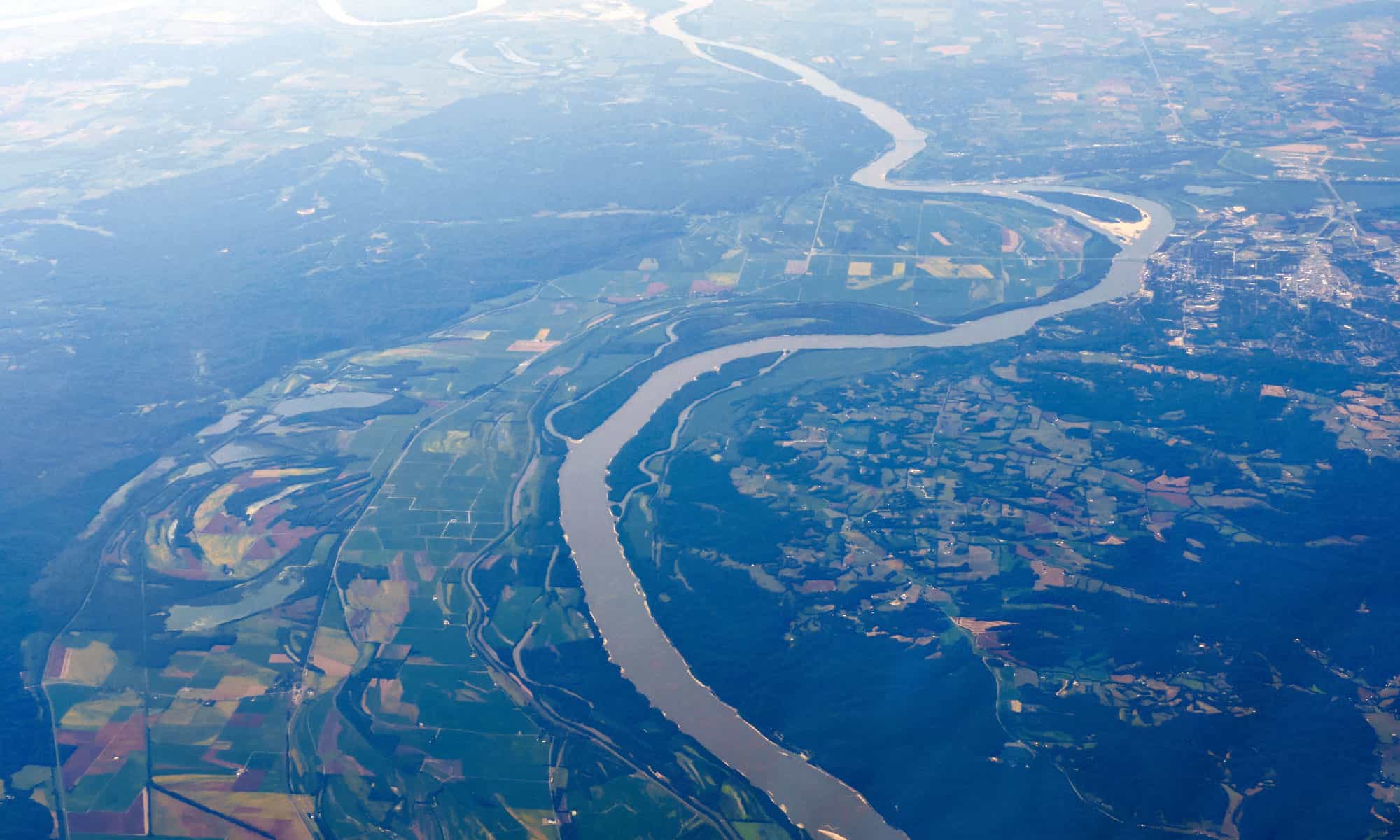The Mississippi River forms one of the largest drainage systems in North America. It is a significant river in the US, with an overall drainage basin of 1.51 million square miles. By discharge, it is among the top 20 largest rivers in the world.
Alarming reports indicate this river has had the lowest water levels in a long time. Therefore, considering its importance to the US, it is a cause for concern.
Read on to learn more about the depreciating levels of the Mississippi and what it means.
About the Mississippi River

©iStock.com/dosecreative
The Mississippi River owes its name to the Anishinaabe people, an indigenous tribe that referred to the river as Misi-ziibi, meaning the great river. Its source is Lake Itasca, a glacial lake in north-central Minnesota. It snakes its way south past ten states, including Iowa, Wisconsin, Illinois, Tennessee, Kentucky, and more, to its mouth, the Gulf of Mexico.
Its mouth is a delta, the Mississippi River Delta, in Louisiana, and covers roughly 4,700 square miles.
The Mississippi River Delta is home to 40% of the lower 48 states’ coastal wetlands. The wetlands, which cover millions of acres, resulted from the river’s floodwaters depositing huge amounts of sediments at its delta.
Today, the wetlands include interior forested wetlands, the Gulf of Mexico’s barrier islands, and several interconnected habitats. The habitats, which are home to millions of fish, birds, and other wildlife, include:
- Salt marshes
- Brackish
- Freshwater
How Did The Mississippi River Form?
The formation of the Mississippi River was due to the action of ice sheets, notably Laurentide, during the last Ice Age. The glaciers eroded the surface and washed away the top rock layers, creating the Mississippi River basin. Later, the glaciers melted, and the water flowed through the basin, heading southwards.
Initially, the consensus was this great river came to be around 20 million years ago. However, a 2018 research conducted by a team from South Illinois University discovered evidence pointing at the river’s age to be approximately 70 million years.
Divisions of the Mississippi River
This giant river has three divisions:
- The upper Mississippi division
- The middle Mississippi division
- The lower Mississippi division
The Upper Mississippi Division
This division has two subdivisions. The first is the headwaters, extending almost 500 miles from Lake Itasca, halting at Saint Anthony Falls, Minneapolis. The second subdivision runs between Minneapolis and St. Louis. There is a series of manmade lakes in this subdivision, forming a navigable channel that flows for 664 miles.
The Middle Mississippi Division
The Middle Mississippi starts from the confluence at St. Louis, flowing 190 miles to the intersection with the Ohio River. The meeting point is in Cairo, Illinois.
The Lower Mississippi Division
The Lower Mississippi is the longest division at roughly 1000 miles. The starting point of this division is the confluence with the Ohio River and ends at its mouth.
The Depth of the Mississippi River

The average depth of the Mississippi River is nine to 12 feet deep.
©Milen Mkv/Shutterstock.com
To understand the alarm that is the fluctuating water levels of the Mississippi, you have to know its depth. This 2340-mile river starts small at its source, 20-30 feet wide and 18 inches deep.
As it flows downstream, its width increases. The widest it gets is at Lake Winnibigoshish, at 11 miles, while the broadest navigable channel is at Lake Pepin, which is around two miles wide.
The average depth of this giant river is nine to 12 feet deep. Its deepest point is at Algiers Point in New Orleans. Lake Pepin is the largest and deepest lake on the course of the Mississippi, 60 feet deep.
The Significance of the Mississippi River and Why the Depth Matters
The depth is crucial for several economic purposes. But first, let us look at how significant the river is and why its depth matters.
It Is a Source of Livelihood for Many People
The Mississippi River has been a source of livelihood for Americans for many years. The native tribes camped around the river for fish and water. The upper division was once a thriving freshwater fish source, accounting for up to 260 species.
The river provides water to several households in the United States. Therefore, declining water levels mean there will be a reduction in the water supply. Also, the low levels translate to declining aquatic life, which will affect the fishing industry and food supply.
It Is a Means of Transportation
The Old Man River, another name for the Mississippi River, is navigable and a crucial means of transport. For a river to be passable, it should be deep enough for water vessels to sail smoothly. Unfortunately, the depreciating water levels have a severe effect on water transport.
Barges are common on the course of the Mississippi River, coming in handy in transporting tons of products. However, it would be more expensive to transport products, such as grain, via other means, as the barges have a bigger carrying capacity.
The low water levels in parts like Memphis, Tennessee, led to several barges getting stuck. The situation called for dredging to allow the passage of the vessels. Unfortunately, the economic effect is devastating, as dredging is expensive, and the barges have to reduce their carrying capacity.
It Is Power Source
The Upper Mississippi has several dams, which serve various purposes, including electricity generation. Therefore, if the water drop situation gets severe, it may affect electricity production.
It Carries a Cultural Significance
The Mississippi is America’s cultural treasure, joining ten states as it flows toward the Gulf of Mexico.
Some portions of the river act as state boundaries, separating east-located states like Wisconsin, Illinois, Tennessee, Mississippi, and Kentucky from west-located Iowa, Missouri, and Arkansas. The river also divides the US into the western and eastern parts.
The Old Man River has been the subject of various literary works, notably by Mark Twain. The river is a tourist attraction, attracting several sightseers enchanted with its presence. In addition, the Mississippi River is a hub for recreational activities like boating, swimming, and water skiing.
Why Is the Mississippi River Experiencing Low Water Levels?

Memphis has suffered the lowest point of drought in the Mississippi River.
©iStock.com/Kruck20
The Mississippi River had one of the lowest water levels in October 2022, a record of -10.81 feet, more than the -10.7 feet experienced in 1988. As mentioned earlier, the dipping water levels had a massive economic impact on transport.
But what caused the low water levels? The following are possible explanations for the worrying situation.
Climate Change
It is not a secret that the climate is changing rapidly due to global warming and other culprits. As a result, many rivers in the world experienced alarming drops, including Europe’s Rhine River and the Yangtze in China.
The United States faced intense flash droughts in 2022, which affected precipitation, and, subsequently, water levels. In addition, the dry soil holds plenty of water, reducing flow to rivers through surface runoff.
Memphis was one of the most affected states, with the drought hitting it in late June 2022, stretching into October. The flash drought patterns changed immensely, with the situation worsening more than in previous years.
The explanation is that the previous droughts mainly affected the Mississippi’s tributaries. However, the 2022 drought hit the central parts of the county, affecting the river’s primary flow due to increased water absorption by the soil and high evaporation.
Presence of Manmade Structures on The River’s Course
Several manmade structures punctuate the course of the Mississippi River. These structures include dams and levees, which serve various purposes like controlling flooding and improving navigation.
While the facilities are significant in managing the river’s water flow, they present drawbacks, such as reducing the downstream flow and disrupting aquatic ecology.
The Impact of the Low Water Levels
The low water levels have severely impacted the economy, considering the river’s significance.
As stated previously, several barges move across the Mississippi River to deliver grains and other goods. The vessels have a carrying capacity of up to 1500 tons for dry cargo and 2500 tons for liquid cargo.
During the peak of the low water levels, the barges reduced their carrying capacity and movement across the river. It led to a 45% reduction in activity, which spells around $20 billion in losses. Dredging the waterways and towing and repairing the vessels add to the expenditure.
Parts of Tennessee were an eyesore for a long time, with boats that floated on the river’s waters getting stuck in the mud.
Moreover, there is the risk of salty water from the Gulf of Mexico entering the river, contaminating drinking water.
The situation’s silver lining is the exposure of ancient artifacts on the river’s basin, like a 19th Century sunken trade ship. Treasure hunters are having a field day looking for goodies submerged under the river for a long time.
The declining Mississippi River water levels have led to habitat loss for many animals living in the river’s wetlands.
Management of the Situation
The situation forces quick-response measures, like dredging, to allow barges to move. As a result, barge operators have to use other means of transportation, which are costly. Consumers will bear the extra costs, pushing up the cost of living.
The Army Corps of Engineers took charge of the saltwater creeping situation by constructing levees. These structures will prevent the contamination of the Mississippi River’s water by salt from the Gulf of Mexico.
The Current Situation of the Mississippi River
The Great River’s water levels are currently returning to normal due to the early winter rains. As a result, navigation is picking up slowly, with prices dropping, although they are still higher than usual.
The climate has been changing drastically over the past few years, and the Mississippi River may continue to be a victim of the changes. What about the manmade structures on the river’s course?
Dams and other structures can affect water flow, but the impact is relatively low compared to that of drought.
Proper adjustments of the structures can allow for ample water flow downstream, at the same time controlling floods, which can be devastating.
What Does the Future Spell for Mississippi River Levels?
Global warming is still a big problem that affects the climate. Moreover, the increased heat levels can have more severe effects in the future unless we act fast.
The dipping levels of the Mississippi River in 2022 may be a foreshadowing of how things will get.
Conclusion
The Mississippi River is crucial to the United States. It is the backbone of various economic activities such as fishing, transportation, and tourism. In addition, the river passes through ten states down to its mouth, forming a natural boundary between some.
In late 2022, the river’s water levels dropped to historical lows, which was a cause for alarm. For instance, the levels in Memphis, Tennessee, dropped by more than 20 feet. The result was reduced navigation across the critical waterway, spelling countless losses.
The flash drought experienced from mid-summer is the main culprit of the problem, and to a lower extent, the structures built along the river’s course. While the situation improves, it calls for all-around preparation to prevent a recurrence.
Up Next:
Thank you for reading! Have some feedback for us? Contact the AZ Animals editorial team.








